Vietnam, a country of stunning landscapes, rich history, and vibrant culture, has become one of the most sought-after travel destinations in Southeast Asia. From the bustling streets of Hanoi to the serene beaches of Da Nang, Vietnam offers a diverse range of experiences that cater to all types of travelers. However, before embarking on your journey to this beautiful nation, it’s essential to equip yourself with some valuable travel tips. This guide will cover everything you need to know about traveling to Vietnam, ensuring that your trip is not only enjoyable but also hassle-free.
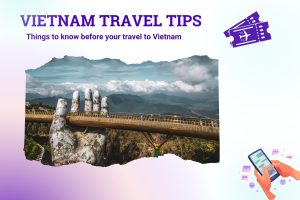
I. Is Vietnam Safe for Travel?
Travel safety is often a primary concern for many tourists, especially when visiting a new country. Fortunately, Vietnam is generally considered safe for travelers, but like any destination, it’s crucial to stay informed and take necessary precautions.
Basic safety awareness along with monitoring regional situations, weather forecasts if traveling during typhoon season, and considering vaccinations makes Vietnam a very low-risk destination, with millions visiting yearly without major security incidents.
II. What is the Best Time to Visit Vietnam
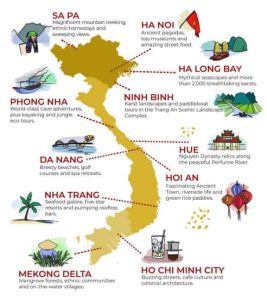
Vietnam’s climate varies significantly from north to south, making it essential to choose the right time to visit based on your itinerary.
Northern Vietnam
The best time to visit northern Vietnam, including Hanoi and Halong Bay, is from October to April. During these months, the weather is cooler and drier, making it ideal for outdoor activities. However, be prepared for occasional drizzles, especially in winter. The landscape is breathtaking during this period, with lush greenery and clear skies.
Central Vietnam
Central Vietnam, home to cities like Hue and Da Nang, experiences a tropical climate. The best time to visit is from February to August when rainfall is minimal, and temperatures are pleasant. However, be cautious of typhoon season, which typically occurs from September to November, bringing heavy rains and strong winds.
Southern Vietnam
Southern Vietnam, including Ho Chi Minh City and the Mekong Delta, is warm year-round. The dry season runs from December to April, making it the best time to explore this region. However, if you prefer fewer crowds and lower prices, consider visiting during the rainy season (May to November), when showers usually come in short bursts.
III. Visa for Vietnam
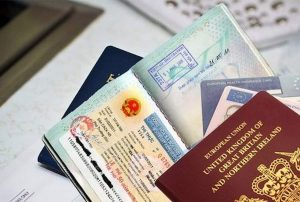
Navigating visa requirements can be daunting for international travelers, but understanding the process can make your entry into Vietnam smooth and stress-free.
Types of Visas Available
Vietnam offers various types of visas depending on the purpose of your visit. The most common is the tourist visa, which allows stays of up to 30 days. You can apply for an e-visa online, which is convenient and efficient. For longer stays or business purposes, consider applying for a different type of visa through the nearest Vietnamese embassy or consulate.
E-Visa Application Process
Applying for an e-visa is straightforward. Visit the official website, fill out the application form, upload your passport photo, and pay the processing fee. Once approved, you’ll receive your e-visa via email, which you must print and present upon arrival in Vietnam. Be sure to apply at least a week before your travel date to allow for processing time.
Visa Exemption Policies
Certain nationalities are eligible for visa exemptions for short visits. Check the latest regulations to see if your country qualifies. If you plan to stay longer than the allowed period, ensure you apply for an extension before your visa expires to avoid fines or legal issues.
IV. Do I Need a SIM Card for Vietnam/Internet in Vietnam for Tourists
Staying connected while traveling is essential for navigation, communication, and sharing your experiences. In Vietnam, there are several options for accessing the internet.
Purchasing a Local SIM Card
Buying a local SIM card is a popular choice among travelers. Major providers like Viettel, Mobifone, and Vinaphone offer affordable prepaid plans with data packages. You can purchase a SIM card at the airport, convenience stores, or mobile shops throughout the country. Make sure your phone is unlocked and compatible with local networks.
Using Wi-Fi in Vietnam
Wi-Fi is widely available in urban areas, hotels, cafes, and restaurants. Many establishments offer free Wi-Fi access, making it easy to stay connected without a SIM card. However, relying solely on public Wi-Fi can be risky; consider using a VPN to protect your personal information.
eSIM as a New Solution for Tourists
For tech-savvy travelers, eSIM technology presents a modern solution. An eSIM is a digital SIM that allows you to activate a cellular plan without needing a physical SIM card. Some top providers offer eSIM for Vietnam specifically designed for travelers, include Gigago, Vietnamesim, Airalo, and Holafly. With a wide range of flexible plans starting at just $8.90, Vietnamesim is a top choice for hassle-free connectivity while traveling in the country.
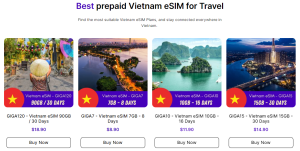
V. What to Pack for Vietnam
Packing wisely can enhance your travel experience in Vietnam. The country’s diverse climate and cultural norms necessitate thoughtful preparation.
Clothing Essentials
When packing clothes for Vietnam, consider the climate of the regions you’ll be visiting. Lightweight, breathable fabrics are ideal for hot and humid weather. In northern Vietnam, pack layers for cooler evenings, while southern regions require light clothing. Don’t forget comfortable walking shoes for exploring cities and natural attractions. Additionally, bring a swimsuit for beach destinations and a light rain jacket if you’re traveling during the wet season.
Toiletries and Medications
While you can find toiletries in Vietnam, it’s wise to bring your essentials, especially if you have specific brand preferences. Include sunscreen, insect repellent, and basic medications for common ailments. A small first aid kit can also be handy for minor injuries. If you take prescription medications, ensure you have enough for your trip and carry a copy of your prescriptions.
Travel Accessories
Consider packing travel accessories that can enhance your comfort and convenience. A portable charger is essential for keeping your devices powered during long excursions. A reusable water bottle with a built-in filter can help you stay hydrated while reducing plastic waste. Don’t forget a travel adapter for charging your electronics, as Vietnam uses Type A, C, and D plugs.
VI. How Much Does a Trip to Vietnam Cost?
Understanding the cost of travel in Vietnam can help you budget effectively and make the most of your experience.
Accommodation Costs
Vietnam offers a wide range of accommodation options to suit every budget. Hostels and guesthouses provide affordable stays, while mid-range hotels and luxury resorts cater to those seeking more comfort. On average, you can expect to pay around $10-$20 per night for budget accommodations, $30-$70 for mid-range hotels, and upwards of $100 for luxury options. Booking in advance can help you secure better rates.
Transportation Expenses
Getting around Vietnam is relatively inexpensive. Domestic flights are available for long distances, while buses and trains connect major cities. Local transportation options include taxis, ride-hailing apps like Grab, and motorbike rentals. The budget is around $1-$5 for short rides and $20-$50 for longer journeys. If you plan to rent a motorbike, factor in costs for fuel and insurance.
Food and Activities
Vietnamese cuisine is both delicious and affordable. Street food meals can cost as little as $1-$3, while dining in restaurants may range from $5-$15 per meal. Allocate a budget for activities and entrance fees, which vary by location. Popular attractions like Halong Bay cruises or guided tours may cost between $30-$100. To save costs, consider free activities like exploring local markets or hiking in national parks.
Tips for Saving Costs
To maximize your travel budget, consider traveling during the off-peak season when prices are lower. Opt for local eateries instead of touristy restaurants for authentic and affordable meals. Use public transportation whenever possible, and look for discounts on attractions or tours. Bargaining is common in markets, so don’t hesitate to negotiate prices for souvenirs.
VII. Best Things to Do in Vietnam
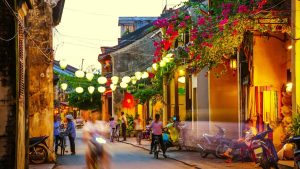
Vietnam is brimming with incredible experiences that cater to all interests. Here are some must-do activities during your visit.
Explore the Natural Wonders
Vietnam boasts stunning natural landscapes, from the limestone karsts of Halong Bay to the terraced rice fields of Sapa. Take a boat tour in Halong Bay to witness its breathtaking scenery, or trek through the hills of Sapa to immerse yourself in the beauty of the countryside. National parks like Phong Nha-Ke Bang and Cat Ba Island offer opportunities for hiking, caving, and wildlife spotting.
Discover Historical Sites
Vietnam’s rich history is reflected in its numerous historical sites. Visit the ancient town of Hoi An, a UNESCO World Heritage site known for its well-preserved architecture and vibrant lanterns. Explore the Cu Chi Tunnels near Ho Chi Minh City to learn about the Vietnam War’s impact. The Imperial City in Hue showcases the grandeur of Vietnam’s royal past.
Experience Local Culture
Immerse yourself in Vietnamese culture by participating in local festivals, cooking classes, or traditional performances. Attend a water puppet show in Hanoi for a unique cultural experience. Join a cooking class to learn how to prepare iconic dishes like pho or spring rolls. Engaging with locals and learning about their customs will enrich your travel experience.
Enjoy the Culinary Delights
Vietnamese cuisine is renowned for its fresh ingredients and bold flavors. Don’t miss trying iconic dishes like pho, banh mi, and bun cha. Street food tours are a fantastic way to sample a variety of dishes while exploring local neighborhoods. For dessert, indulge in sweet treats like che (a Vietnamese dessert soup) or coconut ice cream.
VIII. What to Buy in Vietnam
Shopping in Vietnam can be an exciting adventure, offering a wide array of unique products and souvenirs.
Handcrafted Souvenirs
Vietnam is famous for its handicrafts, including lacquerware, silk products, and pottery. Visit local markets to find beautifully crafted items that reflect the country’s artistry. Look for handmade goods like embroidered textiles, bamboo products, and traditional wooden carvings. These souvenirs not only support local artisans but also serve as memorable keepsakes from your trip.
Traditional Clothing
Consider purchasing traditional Vietnamese clothing, such as the ao dai, a graceful dress worn by women. Tailors in cities like Hoi An can create custom-made ao dais to fit your style and measurements. Men can also find tailored suits or shirts made from high-quality fabrics. Wearing these garments during your travels adds a touch of authenticity to your experience.
Local Snacks and Ingredients
Bring home a taste of Vietnam by purchasing local snacks and ingredients. Dried fruits, nuts, and specialty teas make excellent gifts for friends and family. Look for Vietnamese coffee, known for its robust flavor, or buy spices to recreate your favorite dishes at home. Many markets offer packaged snacks that are perfect for sharing.
Art and Decor
Vietnamese art is vibrant and diverse, ranging from traditional paintings to contemporary pieces. Visit galleries or artisan workshops to find unique artworks that resonate with you. Consider purchasing decorative items like hand-painted ceramics or traditional prints to adorn your home. These pieces will remind you of your travels long after you’ve returned.
IX. What to Eat in Vietnam
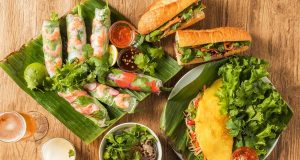
Vietnamese cuisine is a delightful fusion of flavors, textures, and aromas. Exploring the local food scene is one of the highlights of any trip to Vietnam.
Iconic Dishes
Vietnam is known for its iconic dishes that showcase the country’s culinary heritage. Pho, a fragrant noodle soup, is a must-try dish found throughout the country. Bun cha, grilled pork served with vermicelli noodles, is a specialty of Hanoi. Don’t miss trying banh mi, a delicious Vietnamese sandwich filled with various ingredients. Each region has its own specialties, so be sure to sample local variations.
Street Food Adventures
Street food is an integral part of Vietnamese culture, offering an authentic taste of local life. Wander through bustling markets and food stalls to discover a plethora of options. Try fresh spring rolls, crispy banh xeo (Vietnamese pancakes), and savory dumplings. Street food is not only affordable but also provides an opportunity to interact with locals and learn about their culinary traditions.
Regional Specialties
Vietnam’s diverse geography influences its cuisine, resulting in regional specialties that reflect local ingredients and flavors. In the north, enjoy dishes like cha ca (grilled fish) and sticky rice. Central Vietnam is known for its spicy flavors, with dishes like mi quang (turmeric noodles) and banh beo (steamed rice cakes). In the south, savor sweet and sour dishes like canh chua (sour soup) and enjoy tropical fruits like mango and rambutan.
Desserts and Beverages
Indulge your sweet tooth with Vietnamese desserts, which often feature coconut milk, beans, and fruits. Che, a dessert soup, comes in various forms and is a popular treat. For beverages, try Vietnamese iced coffee, known for its strong flavor and sweetness. Fresh fruit juices and smoothies are also widely available, providing a refreshing way to cool down in the tropical heat.
X. Vietnam Travel Tips
As you prepare for your adventure in Vietnam, here are some additional travel tips to enhance your experience.
Stay Hydrated
Vietnam’s tropical climate can be hot and humid, so staying hydrated is crucial. Carry a reusable water bottle and refill it with bottled water to reduce plastic waste. Drink plenty of fluids, especially if you’re engaging in outdoor activities.
Learn Basic Vietnamese Phrases
While many people in urban areas speak English, knowing a few basic Vietnamese phrases can be helpful. Simple greetings, thank you, and asking for directions can go a long way in connecting with locals and enhancing your travel experience.
Respect Local Customs
Vietnamese culture places great importance on respect and politeness. When interacting with locals, use a friendly tone and maintain eye contact. Be mindful of cultural norms, such as removing your shoes before entering homes or temples. Understanding and respecting local customs will foster positive interactions.
Plan Your Itinerary Wisely
Vietnam offers a wealth of experiences, so planning your itinerary carefully is essential. Prioritize the destinations and activities that interest you the most. Allow for flexibility in your schedule to accommodate spontaneous adventures and discoveries along the way.
XI. Conclusions
Traveling to Vietnam is an enriching experience that promises unforgettable memories, stunning landscapes, and delicious cuisine. By equipping yourself with essential travel tips, you can navigate the country with confidence and ease. From understanding safety measures to immersing yourself in local culture, these insights will enhance your journey.
Whether you’re exploring the bustling streets of Ho Chi Minh City, cruising through the breathtaking scenery of Halong Bay, or savoring the flavors of Vietnamese cuisine, each moment in Vietnam is bound to leave a lasting impression. Embrace adventure, connect with locals, and immerse yourself in the beauty of this remarkable country. Happy travels!